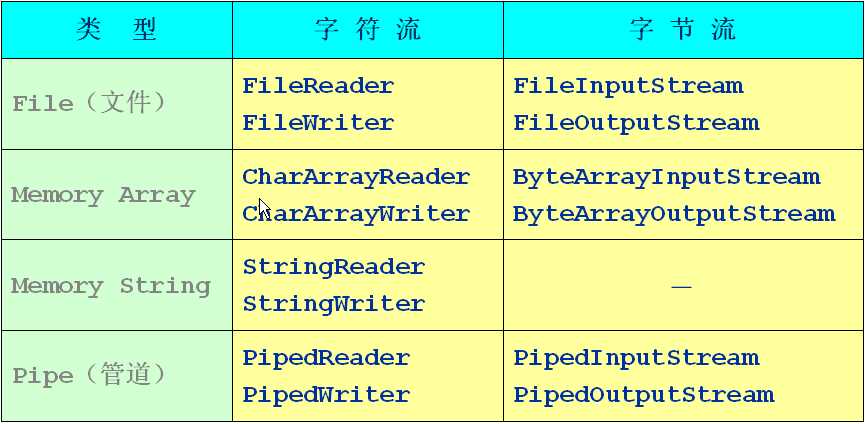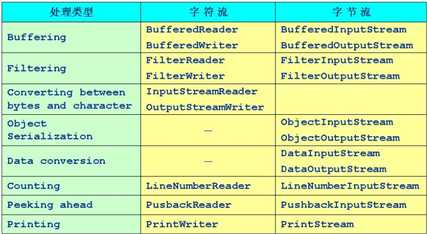标签:bre 个数 nsf 字节 cat 节点 ksh 系统 9.png
流的分类:
按数据流的方向分为输入流和输出流
按处理数据单位不同分为字符流和字节流(一个字符为两个字节)
按照功能不同分为节点流和处理流

节点流为从一个特定的数据源读写数据

处理流是连接在已存在的流上,通过对数据的处理为程序提供更强大的读写功能

InputStream
基本方法:(具体可见API)
int read() throws IOException
//从输入流中读取数据的下一个字节。返回 0 到 255 范围内的 int 字节值。
//如果到达流的末尾,则返回 -1。
int read(byte[] b) throws IOException
//从输入流中读取一定数量的字节,并将其存储在缓冲区数组 b 中。
//读入缓冲区的总字节数;如果因为已经到达流末尾而不再有数据可用,则返回 -1。
int read(byte[] b, int off, int len) throws IOException
//将输入流中最多 len 个数据字节读入 byte 数组。尝试读取 len 个字节,但读取的字节也可能小于该值。以整数形式返回实际读取的字节数。将读取的第一个字节存储在元素 b[off] 中。
//读入缓冲区的总字节数;如果因为已到达流末尾而不再有数据可用,则返回 -1。
void close() throws IOException
//关闭此输入流并释放与该流关联的所有系统资源。
//InputStream 的 close 方法不执行任何操作。
OutputStream
void write(int b) throws IOException
//将指定的字节写入此输出流。
void write(byte[] b) throws IOException
//将 b.length 个字节从指定的 byte 数组写入此输出流
void write(byte[] b, int off, int len) throws IOException
//将指定 byte 数组中从偏移量 off 开始的 len 个字节写入此输出流。
//如果 b 为 null,则抛出 NullPointerException。如果 off 为负,或 len 为负,或者 off+len 大于数组 b 的长度,则抛出 IndexOutOfBoundsException。
void flush() throws IOException
//将输出流中缓冲的数据全部写出到目的地
void close() throws IOException
//关闭此输出流并释放与此流有关的所有系统资源。
//close之前用flush清空缓存
Reader 基本方法:
同上(不同以字符为单位)
Writer基本方法:
public void write(String str) throws IOException
//将字符串写入输出流。
//因为String有toCharArray方法将String转换为字符数组
void write(String str, int off, int len) throws IOException
//写入字符串的某一部分。
// str - 字符串;off - 相对初始写入字符的偏移量;len - 要写入的字符数
节点流类型:

处理流类型:

1、缓冲流:套接在相应字节流之上,对数据的读写提供缓冲的功能。
BufferedWriter、BufferedReader、BufferedInputStream、BufferedOutputStream
注意:
2、转换流: 将字节流转换成字符流
InputStreamReader、OutputStreamWriter
注意:
3、数据流:可以存取JAVA原始类型数据(int,float等)
DataInputStream、 DataOutputStream
4、Print流(打印流)
PrintWriter和PrintStream都属于输出流,分别对应字节和字符
PrintWriter和PrintStream提供了重载的Print
Println可以用于多种数据类型的输出
PrintWriter和PrintStream输出不会抛出异常
PrintWriter和PrintStream有自动flush功能
例 1:InputStream
import java.io.*; public class TestFileInputStream { public static void main(String[] args) { int b = 0; FileInputStream in = null; try { in = new FileInputStream("d:\\share\\java\\io\\TestFileInputStream.java"); } catch (FileNotFoundException e) { System.out.println("找不到指定文件"); System.exit(-1); } try { long num = 0; while((b=in.read())!=-1){ System.out.print((char)b); num++; } in.close(); System.out.println(); System.out.println("共读取了 "+num+" 个字节"); } catch (IOException e1) { System.out.println("文件读取错误"); System.exit(-1); } } }
例2:OutputStream
import java.io.*; public class TestFileOutputStream { public static void main(String[] args) { int b = 0; FileInputStream in = null; FileOutputStream out = null; try { in = new FileInputStream("d:/share/java/HelloWorld.java"); out = new FileOutputStream("d:/share/java/io/HW.java"); while((b=in.read())!=-1){ out.write(b); } in.close(); out.close(); } catch (FileNotFoundException e2) { System.out.println("找不到指定文件"); System.exit(-1); } catch (IOException e1) { System.out.println("文件复制错误"); System.exit(-1); } System.out.println("文件已复制"); } }
例3:Reader
import java.io.*; public class TestFileReader { public static void main(String[] args) { FileReader fr = null; int c = 0; try { fr = new FileReader("d:\\share\\java\\io\\TestFileReader.java"); int ln = 0; while ((c = fr.read()) != -1) { //char ch = (char) fr.read(); System.out.print((char)c); //if (++ln >= 100) { System.out.println(); ln = 0;} } fr.close(); } catch (FileNotFoundException e) { System.out.println("找不到指定文件"); } catch (IOException e) { System.out.println("文件读取错误"); } } }
例4:Writer
import java.io.*; public class TestFileWriter { public static void main(String[] args) { FileWriter fw = null; try { fw = new FileWriter("d:\\bak\\unicode.dat"); for(int c=0;c<=50000;c++){ fw.write(c); } fw.close(); } catch (IOException e1) { e1.printStackTrace(); System.out.println("文件写入错误"); System.exit(-1); } } }
例5:BufferedStream
import java.io.*; public class TestBufferedStream1 { public static void main(String[] args) { try { int b = 0; FileInputStream fis = new FileInputStream("g:/JAVA基础/TestFileInputStream.java" ); BufferedInputStream bis = new BufferedInputStream(fis);//注意BufferedInputStream的构造函数 System.out.println(bis.read()); System.out.println(bis.read()); bis.mark(100); //标记第100个字节 for(int i=0; i<10 && (b=bis.read())!=-1;i++){ // 从第100个字节开始 System.out.print((char)b+" "); } System.out.println(); bis.reset(); //回到第100个字节 for(int i=0; i<10 && (b=bis.read())!=-1;i++){ System.out.print((char)b+" "); } bis.close(); }catch (FileNotFoundException e) { e.printStackTrace(); System.out.println("未找到文件"); } catch (IOException e) { e.printStackTrace(); System.out.println("文件读取错误"); } } }
运行结果:
 不是读到到显示屏上,读到b上,在内存中的一块区域,显示屏上是由于打印的结果
不是读到到显示屏上,读到b上,在内存中的一块区域,显示屏上是由于打印的结果
例6:BufferedWriter BufferedReader
import java.io.*; public class TestBufferedStream2 { public static void main(String[] args) { try { BufferedWriter bw = new BufferedWriter(new FileWriter("g:/JAVA基础/TestFileInputStream.java")); BufferedReader br = new BufferedReader(new FileReader("g:/JAVA基础/TestFileInputStream.java")); String c=null; for(int i=0; i<10; i++){ c=String.valueOf(Math.random()); bw.write(c); bw.newLine(); } bw.flush(); String b=null; while((b=br.readLine())!=null){ System.out.println(b); } bw.close(); br.close(); } catch (FileNotFoundException e) { e.printStackTrace(); } catch (IOException e) { e.printStackTrace(); } }
例7:OutputStreamWriter
import java.io.*; public class TranseForm1 { public static void main(String[] args) { try { OutputStreamWriter osw = new OutputStreamWriter( new FileOutputStream("g:/JAVA基础/TestFileInputStream.java")); osw.write("sdjfghgklhaksh"); System.out.println(osw.getEncoding());//返回此流使用的字符编码的名称 osw.flush(); osw.close(); osw = new OutputStreamWriter( new FileOutputStream("g:/JAVA基础/TestFileInputStream.java",true),"ISO8859-1");//true为续写即接着原来的写 osw.write("sdjfghgklhaksh"); System.out.println(osw.getEncoding()); osw.flush(); osw.close(); }catch (FileNotFoundException e) { e.printStackTrace(); } catch (IOException e) { e.printStackTrace(); } } }
运行结果:
 打开文件 :
打开文件 :

例8:InputStreamWriter
import java.io.*; public class TestTransForm2 { public static void main(String args[]) { InputStreamReader isr = new InputStreamReader(System.in); BufferedReader br = new BufferedReader(isr); String s = null; try { s = br.readLine(); while(s!=null){ if(s.equalsIgnoreCase("exit")) break; System.out.println(s.toUpperCase()); s = br.readLine(); } br.close(); } catch (IOException e) { e.printStackTrace(); } } } //阻塞
例9:DataInputStream,DataOutputStream
import java.io.*; public class TestDataStream { public static void main(String[] args) { ByteArrayOutputStream bao = new ByteArrayOutputStream (); DataOutputStream dos = new DataOutputStream(bao); try { dos.writeDouble(Math.random()); dos.writeBoolean(true); ByteArrayInputStream bai = new ByteArrayInputStream(bao.toByteArray()); DataInputStream dis = new DataInputStream(bai); System.out.println(bai.available()); System.out.println(dis.readDouble()); System.out.println(dis.readBoolean()); dos.close(); dis.close(); } catch (IOException e) { e.printStackTrace(); } } }
运行结果:

例10:PrintStream
import java.io.*; public class TestPrintStream1 { public static void main(String[] args) { try { FileOutputStream fos = new FileOutputStream("g:/JAVA基础/TestFileInputStream.java"); PrintStream ps = new PrintStream(fos); if(ps!=null){ System.setOut(ps);//将输出方向指向Ps } for(int i = 0 ; i < 100 ; i++){ System.out.print((char)i + " "); } } catch (FileNotFoundException e) { e.printStackTrace(); } } }
标签:bre 个数 nsf 字节 cat 节点 ksh 系统 9.png
原文地址:http://www.cnblogs.com/Lune-Qiu/p/7450275.html